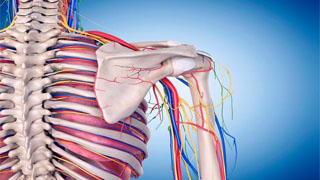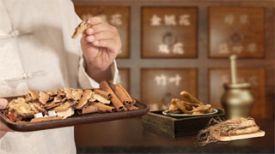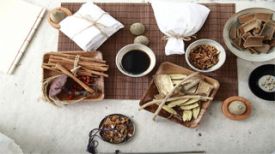
The scapula is a triangular flat bone located on the posterior side of the thorax. It is an important component of the shoulder strap and forms a shoulder joint with the clavicle and sternum to connect the upper limbs and torso. Its structure is complex, consisting of the anterior subscapular fossa and the posterior scapular spine, divided into the medial scapular glenoid and the lateral scapular body. The scapular glenoid forms the glenohumeral joint with the humeral head.
The scapula is crucial in movement, assisting in the movement of the humeral head, adjusting the position of the glenohumeral joint, and aiding in various upper limb movements. Meanwhile, scapular diseases and injuries are common, such as shoulder arthritis, frozen shoulder, fractures, etc., and there are various treatment methods available.
The impact of torso rotation on scapula:
1. It directly affects its movement. If rotated to the left, the left scapula will rotate upwards and the degree of upward rotation on the right will decrease, which helps maintain body balance and stability, but also affects the degree of rotation within the scapula, maintaining shoulder strap stability and upper limb movement accuracy. When lifting an object with one arm, the rotation of the torso will increase the degree of rotation on the scapula and decrease the degree of internal rotation, affecting upper limb movements.
2. In the flat support movement, it significantly affects the forward/backward tilt and up/down rotation of the scapula, with little impact on its internal/external rotation.
3. Different trunk postures activate the lower trapezius and serratus anterior muscles, increasing the backward tilt of the scapula.
During the process of raising the humerus, when the trunk rotates on the same side, the internal rotation of the scapula decreases, while the external rotation and upward rotation increase; When the trunk rotates on the opposite side, the electromyographic activity of the upper trapezius and serratus anterior muscles increases, while the lower trapezius muscle decreases. The trunk, scapula, and glenohumeral joint form a motion chain, which interacts with each other during rapid upper limb movements, suggesting that trunk muscle exercises should be added to shoulder joint and shoulder circumference rehabilitation training.
Not only does it affect scapular movement, but it can also increase shoulder joint stability and protect the shoulder joint from injury.
Shoulder blade movement and shoulder pain:
Among patients with shoulder joint pain, the degree of scapular rotation is relatively small, which affects shoulder joint function and stability. During rehabilitation, attention should be paid to scapular movement and control.
2. Patients with rotator cuff injuries have a low degree of internal and upward rotation of the scapula, which affects the stability of the shoulder joint. During rehabilitation, attention should be paid to their movement and control.
Specific causes of scapular pain:
1. Muscle injury: Commonly caused by excessive or rapid activity, such as repeated throwing movements leading to muscle nodules and causing neck and shoulder pain.
2. Cervical problems: Cervical small arthritis and other conditions can cause local neck pain, muscle tension, scapular pain, spinal stenosis, intervertebral disc problems, etc., which can also lead to cervical nerve compression and radiation pain.
3. Shoulder problems: rotator cuff tears, frozen shoulders, or shoulder injuries may cause pain around the scapula.
4. Impact on thoracic spine: Thoracic arthritis can cause radiating pain around the scapula, which can be relieved by stretching and strengthening activities.
5. Shoulder blade fracture: Usually caused by direct impact or trauma, such as car accidents, osteoporosis can increase the risk of fracture.
6. Nerve damage in the scapular area: Shoulder weight-bearing or infection can cause it.
7. Suffering from specific heart or lung diseases: Left scapular pain may be a sign of certain heart diseases, such as pericarditis or aortic dissection, and lung cancer may also present as scapular pain.
Application of torso rotation and scapular kinematics:
1. Help clinical doctors understand the mechanisms of shoulder joint diseases and develop more effective rehabilitation and training plans. In the rehabilitation of shoulder joint pain, changing the direction and degree of trunk rotation affects scapular movement and shoulder joint stability; In the rehabilitation of rotator cuff injuries, scapular training is used to improve rotator cuff stability and muscle coordination.
2. Help athletes and coaches understand the mechanisms of upper limb movement and develop more effective training plans. When conducting single arm exercise training, pay attention to the impact of trunk rotation on the scapula and shoulder joints to ensure the effectiveness and safety of the training.
Treatment of scapular pain:
Acupuncture treatment targets include local soft tissues, easily compressed areas of local nerves (suprascapular and infrascapular foramen), cervical and thoracic vertebrae, and antagonistic contralateral pectoral muscles.
Self directed treatment:
1. Exercise: Stretching exercises relieve muscle tension, but be careful when the pain intensifies.
2. Rest: The body has the ability to self heal, and after intense exercise, muscles may tear slightly, requiring time to recover.
3. Cold and hot therapy: Ice compress can quickly relieve pain, reduce inflammation and swelling; Hot compress during muscle tension can promote blood flow and muscle relaxation.
4. Self massage: massage with foam roller or massage ball to find the pain point.
Preventing scapular pain:
1. Stretching the trapezius muscle: Sit in a chair, grab the back of your head with one hand, turn your head to the same side and stretch for 30 seconds, then repeat on the other side.
2. Shoulder joint extension surgery: Stand up and use the other arm to pull the elbow, maintain the extension for 30 seconds, and repeat 3 times for each arm.
3. Chest muscle extension: Stand by the wall, lift your arms against the wall, lean forward and stretch for 30 seconds, repeating 3 times for each arm.
4. "Pistol" Exercise: Relax your shoulders, retract to close your shoulder blades, bend your elbows and lift your arms about 45 degrees, repeat 5 times.
In summary, trunk rotation is closely related to scapular movement, and understanding this relationship can help to understand the mechanisms of upper limb movement and facilitate effective rehabilitation and training. In sports rehabilitation practice, targeted plans need to be developed to achieve optimal results.


